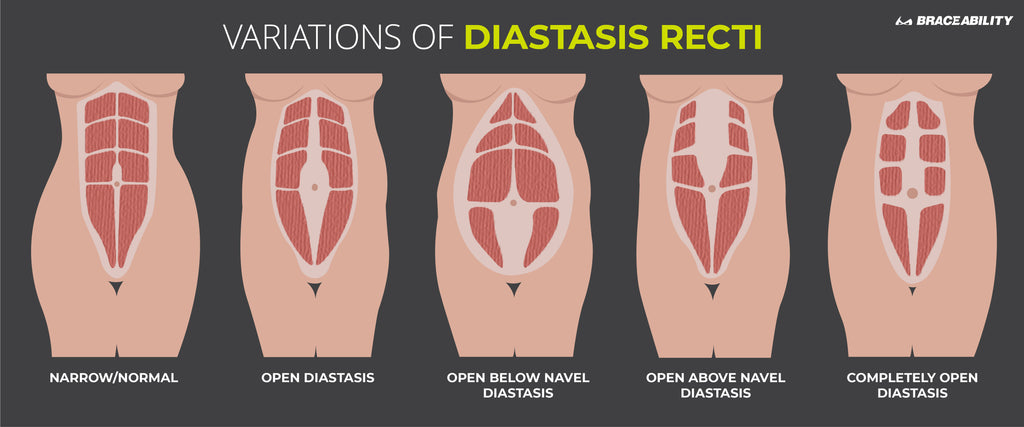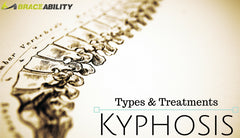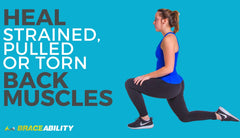Diastasis Recti (Abdominal Muscle Separation)
What Is Diastasis Recti?
To define diastasis recti, let’s consider the words themselves. Diastasis means separation. Recti refers to the abdominal muscles, specifically the rectus abdominis muscles, or the outer-most muscles of your stomach. So this condition quite literally means abdominal muscle separation.
Your abdominal muscles reside on either side of your midline and are connected by a tissue known as linea alba. Various forces can cause these muscles to spread apart, thinning or possibly even tearing the connective tissue.
Pregnancy is a common cause of ab separation, though many other forces that create pressure within the abdominal cavity may also be to blame.
These ab muscles and related connective tissue support the back and organs. When they are separated and thinned, your abdominal wall is weakened, making them less able to do so.
As a result, your belly tends to stick out and you may notice a ridge running down the midline of your belly—picture a half a football or a loaf of bread—that protrudes when you strain or lift your shoulders off the floor.
There are all sorts of fun names for this badge of motherhood, including pooch, mummy tummy, and baby belly. It is also to blame for the dreaded post-natal “when are you due?” question.
A more scientific term you may hear for this form of muscle diastasis is divarication of the recti abdominis or DRAM.

How to Tell if You Have Diastasis Recti
Diastasis recti is classified as a gap of roughly 2.7 cm (just over an inch) or greater between your abdominal muscles, which roughly equates to two fingertips. A gap of four to five fingertips is considered severe diastasis recti.
For a more exact read on your separated abdominal muscles or to check for hernias, you could get an ultrasound. But you can also answer the question “Do I have diastasis recti?” pretty easily yourself.
To Find out if You Have Diastasis Recti, Follow These Steps:
- Lie on the back with the knees bent at 90-degree angles and your feet flat on the ground.
- Place your fingers on your belly with the palm facing you on your belly button. Press down gently.
- Lift your head off the ground and draw your chin to your chest, contracting your abdominal muscles.
- Do you feel a gap of two finger-widths or more? If so, you have diastasis.
- Repeat this test a bit above and a bit below the belly button, as that gap can vary.
Other Symptoms of Abdominal Separation
- Low-back, hip, or pelvic pain
- Digestive issues like constipation or bloating
- Bulging belly
- Outie belly button
- Urine leaks
- Hernia
- Weakened pelvic alignment
- Poor posture
- Trouble breathing/moving normally
- Pain during sex
- Difficult vaginal delivery
The pesky gap between your abs and the bulge that appears when you strain are just a few of a multitude of symptoms separation of the abdominal muscles can cause.
Who Is Most Likely to Have Diastasis Recti?
Men, women, and children can all suffer from separated stomach muscles, but this problem is most often linked with pregnancy, with newborns coming in at the No. 2 spot in terms of prevalence.
Muscle Separation or Tearing During Pregnancy
Around two-thirds of women deal with abdominal separation during pregnancy. The pressure of a growing uterus causes the abdominal muscles to spread apart, and pregnancy-related hormones that cause tissues to relax makes this even more prominent.
Factors that Increase Risk of Ab Separation During or After Pregnancy
- Having more than one child, especially if they’re close in age
- Being over the age of 35
- Having heavy babies or multiples
- Doing excessive abdominal exercises after the first trimester
- Being petite
- Poor abdominal muscle tone preceding pregnancy
- Having a pronounced swayback
- A family history of diastasis (there’s a genetic link)
For most women, this occurs after the 20-week mark, but it only becomes a problem after delivery. The space usually shrinks around eight weeks after birth, but in many cases, an overly wide gap persists months or even years after giving birth.
In fact, around 40% of women have diastasis six months postpartum, and a recent Norway study showed that around a third of mothers have diastasis recti a year after delivery.
If your diastasis recti has not healed three to six months after giving birth, it may not heal without treatment.
Newborns and Abdominal Wall Diastasis
Babies may also be born with muscle separation in the abdomen. This may look like a bubble beneath the skin of the belly between the belly button and the bottom of the breastbone.
It is more common with African American and premature babies but is not something to be too concerned about. Rectus diastasis repair is rarely required because in these cases your baby’s body typically heals itself; your baby’s body just hadn’t gotten around to closing that gap yet.
Abdominal Muscle Separation in Men (and Women who Have Not Had Children)
What causes diastasis recti in men and women who have not given birth is pretty similar to the causes of diastasis during pregnancy: pressure within the abdomen. The source of this pressure is the difference.
Some abdominal exercises, weightlifting, and jobs that require repeated lifting of heavy objects can strain the abdomen and lead to abdominal separation in men and women.
Frequent and rapid weight changes (yo-yo dieting) and obesity can also lead to this condition, as can medical conditions leading to long- or short-term buildup of fluid within the abdominal cavity.
Things that Can Cause Male Diastasis:
- Age (being older)
- Obesity
- Rapid weight changes
- Heavy lifting
- Bodybuilding & weightlifting
- Genetic history of diastasis
- HIV virus (it changes the way the body stores fat and relocates some in the abdominal cavity)
- Abdominal aortic aneurysm
Don’ts: Things That Can Make Abdominal Muscle Separation Worse
When it comes to fixing diastasis recti, things you should avoid doing are just as important as the things you should do to help repair the damage as certain activities can cause your abs to spread even farther apart. Following are some guidelines on things you should avoid to prevent split abdominal muscles or to stop this condition from worsening.
-
Don’t strain yourself
This applies whether you're lifting heavy objects, sitting up or sitting down, or dealing with constipation. The pressure on the abdomen these motions create can further aggravate a split muscle.
-
Don’t lean forward when pushing a stroller
If you've pushed one, you know they are heavier than they look! The pressure on the abdomen created by that leaning / pushing motion can widen the gap between your abdominal muscles.
-
Avoid front-loading baby carriers
The baby weight will put pressure on weak connective tissue. If you must wear one, a better option is to use those slings that hold your baby diagonally across your body and switch to a back-carrier as soon as you can.
-
Avoid certain exercises, yoga poses & sports
Stop certain workouts—basically, ones that jack-knife the body and increase pressure within the abdomen. If your midline is not strong, this can reverse any healing that has occurred. Avoid exercises that push your belly button out and cause the stomach to dome, at least until you have enough control to suck the belly button in while doing them.
Exercises to Avoid if You Have Diastasis Recti:
- Standard crunches
- Crossover/bicycle crunches
- Standard situps
- Double leg raises
- Push-ups
- Press-ups
- Front planks
- Swimming
- Golf
- Tennis
- Softball

Things you Should Do to Help Treat Diastasis Recti
It’s easy to read the above section and think, well, I guess I just won’t workout. But that’s not going to help your situation either. You must work to heal your belly.
Some have success with the Tupler technique and similar methods where you do specific diastasis recti exercises to correct the separation while wearing an abdominal splint that protects and holds the abdominal muscles together.
Once your connective tissues have healed, Pilates and other exercises can help to strengthen your deep core belly muscles (more on those shortly).
You can also limit your ab muscle separation by working to strengthen your core before you get pregnant and during the first trimester.
Another simple step you can take to help with muscle separation and in general is to roll out of bed rather than sitting up. This is also a good idea for the health of your lower back—low back pain is another problem area for many Americans and especially those who are pregnant.
Of course, just living with diastasis recti is an option. But based on the possible complications that can go along with separated abs after pregnancy, that is not necessarily a great option.
And if you plan on having another child, it’s especially important to do gentle ab exercises for diastasis recti repair before getting pregnant again. Your abdominals are more likely to spread with second and third pregnancies (and beyond), plus diastasis recti can lead to some complications with birth itself (more on that later).
If you opt in favor of correcting diastasis recti (good choice), you have two options: 1.) you can repair diastasis recti without surgery, or 2.) you can have surgery to fix diastasis recti.
Usually, Option 1 is the preferable choice and the starting point since surgery is hard on the body, expensive and can lead to complications.
In addition, diastasis recti can usually be fixed without surgery. But if diastasis recti physical therapy, wearing an elastic bandage, etc. does not help, then your doctor may recommend surgery.
4 Steps for How to Fix Diastasis Recti Without Surgery
We already touched on some elements of how to heal diastasis recti in the Dos and Don’ts section. In addition to following those steps, you should also work to do the following.
Step 1: Use Good Posture
Focus on lengthening through the top of the head, engaging the core and maintaining a neutral pelvic position. If you’re standing, make sure you are not locking the knees or tucking your butt (clenching those glutes). These good-posture guidelines apply whether you are sitting, standing, or on the move.
Breathing is another component of good posture that is sometimes overlooked. You should make an effort to breathe deeply into the sides and back of your ribcage, drawing the belly button in gently toward the spine as you exhale.
Doing so will help you to find and tone the deep abdominal muscles that are critical to diastasis recti rehab. For more on good posture, try our 21-day posture challenge.
Step 2: Do Exercises to Strengthen Your Deep Core Muscles
This step has a lot of overlap with Step 1. Exercises to correct diastasis should focus on engaging and working the whole core.
With each exercise you do to heal diastasis recti, you must focus to activate your deep core—relaxing the muscles of your pelvic floor and breathing deeply (as explained above) to zip up the lower belly. This prep work makes the abdominal separation exercises more effective, plus it helps to re-establish the mind/body connection.
The vacuum crunch in its many variations comes up again and again as one of the best exercises for diastasis recti since it engages your transverse abdominal muscles. Here are some instructions for doing it:
Vacuum Crunch: The Best Exercise for Diastasis Recti
- Sit on the floor with your legs crossed and hands on your belly.
- Take a big breath, letting your belly fully expand.
- As you exhale, suck your belly muscles as far back as they’ll go toward the spine.
- Hold there, and then take tiny breaths. With each exhale, push the stomach back further and tighter.
- Try to do this exercise for 10 minutes each day

You can do this abdominal exercise to help diastasis recti in many positions, so long as your back is flat. For example, you can sit on your knees, stand with your knees slightly bent, get down on all fours, or even lay on your side in the fetal position.
Other Exercises to Naturally Heal Diastasis Recti
- squats
- pelvic tilts
- glute bridge
- heel slides
- cat cows
- bird dog
- single-leg kickbacks
- standing rotational exercises
- upright pushups
- head lifts
Step 3: Wear a Diastasis Recti Splint or Binder
Wearing an abdominal brace can help with stomach muscle separation after pregnancy when combined with approved physical therapy or exercises.
These abdominal support belts are most beneficial for a few weeks after delivery or in the initial weeks of treatment for non-pregnancy related diastasis recti.
This particular medical-grade abdominal binder for diastasis recti supports and compresses your low-back and abdomen, helping to reduce swelling and support your weak tissues. The support is also great for symptoms related to diastasis recti, such as low back pain.
It works for males and females and is very easy to put on and adjust. It’s made with hospital-grade fastener that is 10 times stronger than standard, retail-grade fastener. And its moisture-wicking fabric makes it comfortable to wear—even during exercise.
You should not use a diastasis rehab splint long-term, however, as you do not want your muscles to become reliant on the support. Also, while binding can help support weak muscles, it will not encourage reconnection of your mind to the muscles, nor does it engage your transverse muscles.
To fix the problem rather than just the symptom, you will need to do exercises to close abdominal separation in addition to wearing a belly splint for diastasis recti.
Step 4: Consider Physical Therapy for Diastasis Recti
In some cases, you will be able to correct diastasis recti on your own via the methods detailed previously. But for more severe cases, you will likely need to see a physical therapist to heal your belly.
Some women also swear by various in-person or online courses that rely on programs like the Tupler Technique, Keller's Dia Method and the MuTu System, as just a few examples.
Do I Need Surgery to Repair My Diastasis Recti?
In some cases where diastasis recti is considered severe and other corrective methods have failed to get rid of the separation, surgery may be needed to repair the damage.
This is especially true if your connective tissue tears away from the muscles, leaving your organs exposed and increasing your risk of an abdominal or umbilical hernia that could become strangulated.
You may consider wearing a stomach muscle wrap meant to stop the internal organs from herniating outward until/instead of undergoing surgery.
One surgical option for repairing this type of abdominal injury is an abdominoplasty, also known as a “tummy tuck.” With this procedure, a surgeon folds and sews together your weak/or torn central ridge. He or she may also remove excess skin, tissue and/or fat from the area.
A similar procedure can also be done laparoscopically, where the surgeon repairs postnatal muscle separation using several small incisions rather than one big cut.
Be advised that most insurance companies consider diastasis recti repair surgery a cosmetic procedure and therefore they typically will not cover it.
Also, know that surgery is rarely a minor undertaking. You will have some pain during the diastasis recti surgery recovery time.
That period will include limited mobility for a week or two immediately following the procedure. You won’t be able to do any heavy lifting or core exercises for five to six weeks after your surgery to pull your separated abdominal muscles together.
Post-hospital protocol will likely include wearing an abdominal binder around the stomach for a time. This can support the tender tissues and can help bring down swelling.
And know that it can take six months to a year for the swelling abdominal separation surgery causes to subside and scars to flatten, soften and fade. Scar tissue manipulation can help speed along this process and prevent you from developing sensitivity along the incision line.
With any surgery, there is risk of infection and other complications. In some cases, a surgeon may opt to use medical mesh to treat your abdominal muscle injury, and you could be allergic to the material, leading to problems down the road.
Steps You Can Take to Limit Abdominal Separation During Pregnancy
Of course, it’s preferable to stop diastasis recti from happening in the first place rather than addressing the problem after your abdominal muscles have started to separate.
If pregnancy is the cause of your diastasis, the best you may be able to do is to limit the damage. But if you are a man or woman who is not pregnant, there are things you can do to prevent the problem and related symptoms altogether.
Those include:
- Avoiding moves that isolate your abdominal muscles or involve thrusting of your ribs
- Laying down and getting up using correct posture
- Focusing on more comprehensive exercises (like squats) that strengthen the whole body
- Working to strengthen the core before you become pregnant and during the first trimester
- Maintaining a healthy weight (and lose weight if necessary)
- Staying active, even if you are pregnant
Healing Diastasis Recti
Know that it is never too late to repair diastasis recti. Years after giving birth or dealing with some other scenario that caused stomach muscle separation, you can still bring those muscles back together.
How long it will take to heal diastasis recti will depend on the severity of your condition and your commitment to doing the work needed for diastasis correction. Plus, everyone’s connective tissue is different, which means how fast you fix abdominal separation will vary widely.
Weaker connective tissue takes longer to heal and hormones like relaxin or steroid injections can weaken that tissue. Generally speaking, people who are “naturally flexible” and those who get stretch marks are more apt to have weak connective tissue.
For some, diastasis recti recovery (to one finger width of separation) may take as little as six weeks, but for others, that timeframe can stretch out to a year or more. But the good news is you will likely start seeing results by the three-week mark.
Know that you may have to go through the process of treating diastasis recti more than once. You will always have a weak spot in the middle of your abdominal connective tissue—the belly button. Pressure on this weak spot via another pregnancy, weight gain or some other condition can cause stomach muscle diastasis and its many fun symptoms to flare up again.
A Note on C-sections and Abdominal Diastasis
A cesarean delivery can make closing abdominal muscle separation after pregnancy more difficult. Mobilizing the scar tissue via massage can help with this.
Conversely, having diastasis can up the odds of needing a C-section. Specifically, if your connective tissue is weak, it won’t be able to support a top-heavy uterus. As a result, the top of the uterus may tilt forward and throw off the alignment of your cervix. This makes it less likely you’ll be able to have a vaginal delivery. Learn more about steps you can take to get your baby in an optimal position for delivery.






